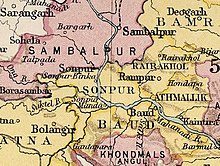Baudh State
| Baudh State | |||||||
|---|---|---|---|---|---|---|---|
| Vassal stateofMaratha Confederacy(1751 - 1804) Princely StateofBritish India | |||||||
| 14th century–1948 | |||||||
|
Flag | |||||||
 Baudh State in theImperial Gazetteer of India | |||||||
| Area | |||||||
• 1921 | 3,274 km2(1,264 sq mi) | ||||||
| Population | |||||||
• 1921 | 130,103 | ||||||
| History | |||||||
• Established | 14th century | ||||||
| 1948 | |||||||
| |||||||
Baudh State,also known asBoudh State,was one of theprincely statesofIndiaduring theBritish Raj.It was recognized as a state in 1874 and had its capital inBoudhtown. Its last ruler signed the document of accession to the Indian Union on 1 January 1948.
History
[edit]According to traditions, after the fall of theSomavamshi dynastyto Eastern Gangas, local chieftains were installed in the region as feudatories. A childless Brahmin chieftain adopted the nephew of the neighbouring Raja of Keonjhar who belonged to theBhanj dynasty.This prince styled himself Ananga Deva and founded the state in the 14th century.[1]
Maratha Rule
[edit]During the Maratha rule in Orissa, the territory of Boudh experienced a more direct Maratha influence than it had under Muslim rule, primarily due to its strategic location. The Maratha administration at Cuttack, controlled by the supreme government at Nagpur, frequently moved troops through the Barmul pass and other routes in western Orissa, making Boudh a critical link. The Raja of Boudh, like other regional rulers, paid tribute (peshkush) to the Maratha government and maintained amicable relations. When Maratha officers collecting peshkush at Sonepur were attacked, they fled to Boudh, where the Raja captured the insurgents and sent them to Nagpur, earning the Raja a prestigious title. However, relations soured in 1800 when Vyankoji, a Maratha leader, was snubbed by the Raja of Boudh, leading to a punitive Maratha invasion that subdued the Raja. Later, during the British invasion of Orissa, the Marathas retreated to the fort of Barabati at Cuttack and then to Boudh after the British captured the fort. The Raja of Boudh hesitated to submit to the British, observing the Maratha forces mobilizing at Barmul pass. After Major Farbes and his British force expelled the Marathas from Barmul, the Raja of Boudh submitted and entered a treaty with the East India Company on March 3, 1804.[2]
See also
[edit]References
[edit]- ^ODISHA DISTRICT GAZETTEERS BOUDH(PDF),GAD, Govt of Odisha, 1991, p. 23
- ^Senapati, Nilamani; Kuanr, Durge Charan.Orissa district gazetteers: Boudh-Khondmals.Gazetters Unit, Orissa. p. 37-38.

